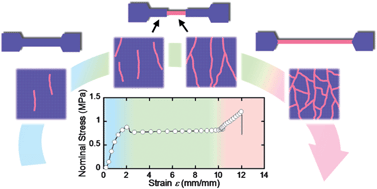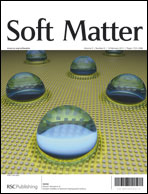Characterization of internal fracture process of double network hydrogels under uniaxial elongation†
Abstract
Previously we revealed that the high toughness of double network hydrogels (DN gels) derives from the internal fracture of the brittle network during deformation, which dissipates energy as sacrificial bonds. In this study, we intend to elucidate the detailed internal fracture process of DN gels. We quantitatively analysed the tensile hysteresis and re-swelling behaviour of a DN gel that shows a well-defined necking and strain hardening, and obtained the following new findings: (1) fracture of the 1st network PAMPS starts far below the yielding strain, and 90% of the initially load-bearing PAMPS chains already break at the necking point. (2) The dominant internal fracture process occurs in the necking and hardening region, although the softening mainly occurs before necking. (3) The internal fracture efficiency is very high, 85% of the work is used for the internal fracture and 9% of all PAMPS chains break at sample failure. (4) The internal fracture is anisotropic, fracture occurs perpendicular to the tensile direction, in preference to the other two directions, but the fracture anisotropy decreases in the hardening region. Results (1) and (2) are in agreement with a hierarchical structural model of the PAMPS network. Based on these findings, we present a revised description of the fracture process of DN gels.


 Please wait while we load your content...
Please wait while we load your content...